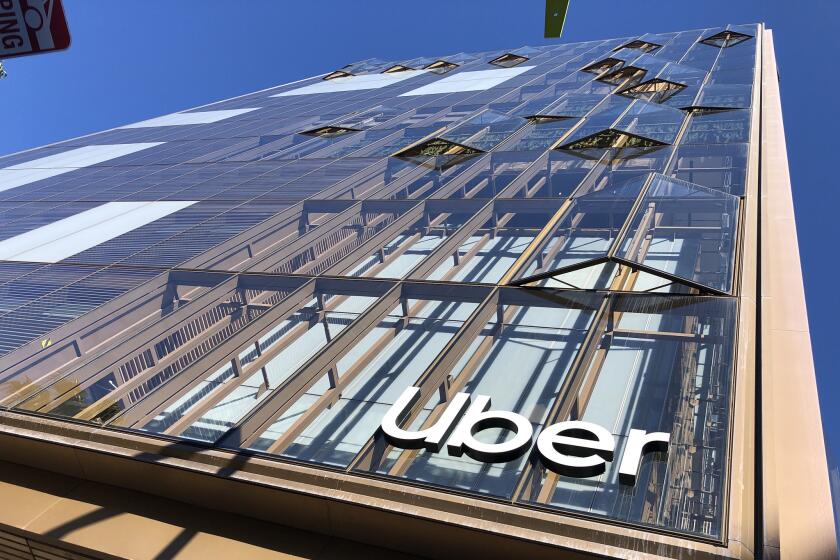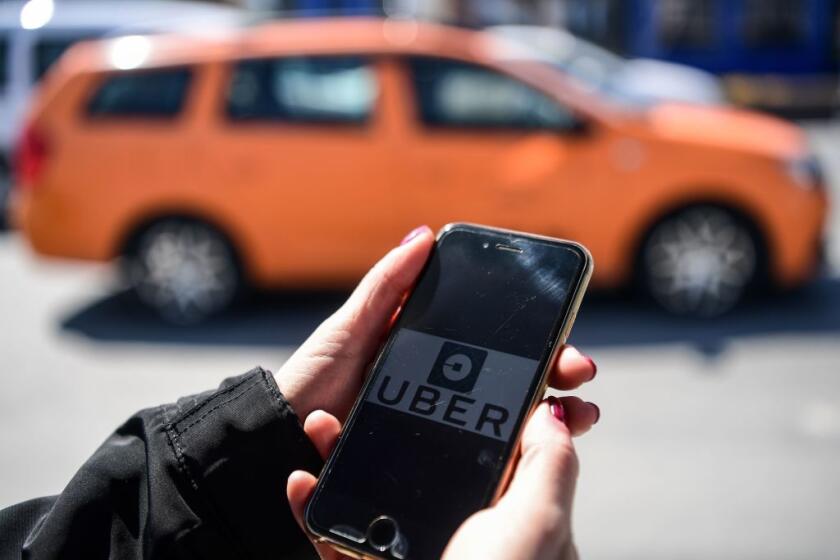Uber taps a new user base with ride and delivery option for teenagers

- Share via
Uber Technologies is expanding its rider base with a new service that lets teenagers hail a trip and ride alone.
The teen rides program allows 13- to 17-year-olds to operate their own Uber account after parents add them to a family profile, the company announced Wednesday. The San Francisco-based firm, which had been piloting the program in the U.S. and Canada for more than a year, will launch the service next week in 14 cities including Atlanta, Dallas, Nashville, New York and Phoenix. (Los Angeles is not on the launch list.)
Parents will be able to track their teens’ trips in real time and contact drivers directly. The rides will come with extra safety measures, Uber said, including a PIN verification system and an audio recording option, which can be activated by passengers and drivers. The audio file is stored on an individual’s app and is encrypted so that it’s accessible by Uber only if a user opens an incident report.
Teen rides are restricted to “highly rated, experienced drivers,” Uber said. All drivers on Uber’s platform are required to pass a background check that includes driving records and a “comprehensive” criminal history report that reveals offenses from the county to federal level, Sachin Kansal, head of safety products, said in an interview. Uber requires drivers to pass a background check on an annual basis and receives alerts that flag DMV and criminal record updates.
“It is all about helping you manage the craziness that encompasses family life in 2023,” Chief Executive Dara Khosrowshahi said. “It has incredible safety features embedded in it from the booking experience all the way to the end of the trip so that you as a parent can have peace of mind, which absolutely is something that’s priceless.”
The California Public Utilities Commission softened its rule but still enacted comprehensive measure to prevent attacks in ride-hailing vehicles.
Uber has had a complicated history with unaccompanied minors. Early on, parents seized on Uber as a carpool alternative, ordering cars to shuttle their children to after-school events such as soccer practice and other activities. Many teens set up their own accounts, even though Uber requires users to be 18 or older and drivers are allowed to ask for an ID to verify age. Crosstown rival Lyft doesn’t allow minors to ride without an adult.
Uber’s teen program legitimizes the practice and presents a lucrative opportunity for Uber to tap a new pool of riders. The percentage of teen drivers in the U.S. has more or less plateaued at a far lower level than a few decades ago. In 2022, only 25.3% of 16-year-olds had a driver’s license, about the same as in 2018 and down from 47.8% in 1984, according to the latest statistics from the Federal Highway Administration.
The business of ferrying children around town is a hard task that comes with increased liability that not many companies are willing to bear. A handful of companies, including HopSkipDrive and Zum, explicitly focus on getting kids to and from school. HopSkipDrive allows parents to arrange a ride for children as young as 6.
This isn’t Uber’s first time attempting to offer rides to unaccompanied minors. The company tried to roll out the offering in 2017 at a time when it was embroiled in a series of scandals under former CEO Travis Kalanick, who left the company that same year. Uber has worked hard to repair its image under Khosrowshahi, who imposed new safety measures and disclosures, including publishing Uber’s first safety report in 2019.
Uber’s teen service was one among a slate of new offerings the company announced at its annual product event in New York, including the ability to book rides via a phone call in the U.S. and bookable boats in Mykonos, Greece, over the summer. Teens will also be able to set up their own accounts on Uber Eats to pay for meals and deliveries.
With reams of data at their disposal, companies like Uber and Amazon are demolishing the notion that people who do the same work should receive the same pay for it.
More to Read
Inside the business of entertainment
The Wide Shot brings you news, analysis and insights on everything from streaming wars to production — and what it all means for the future.
You may occasionally receive promotional content from the Los Angeles Times.












